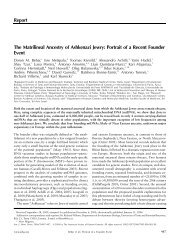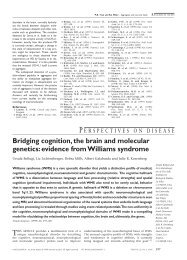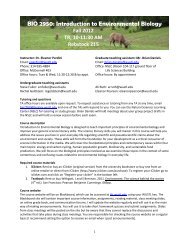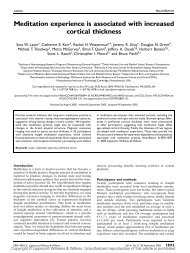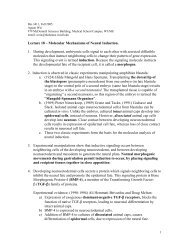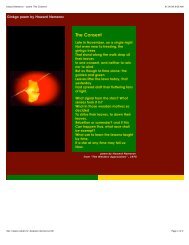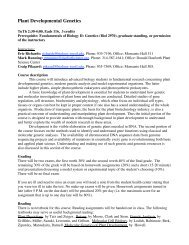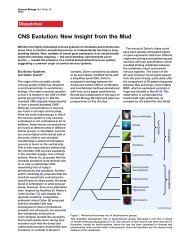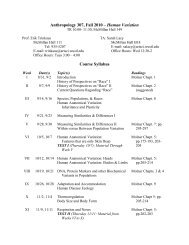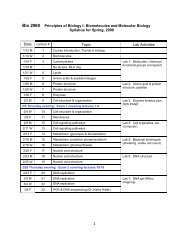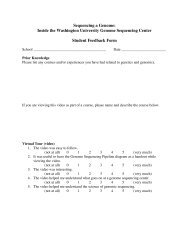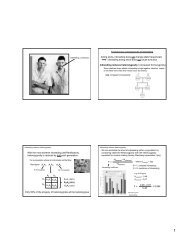Expression Cloning of noggin, a New Dorsalizing Factor Localized ...
Expression Cloning of noggin, a New Dorsalizing Factor Localized ...
Expression Cloning of noggin, a New Dorsalizing Factor Localized ...
You also want an ePaper? Increase the reach of your titles
YUMPU automatically turns print PDFs into web optimized ePapers that Google loves.
Cell<br />
838<br />
lower than the quantity needed for axis rescue <strong>of</strong> ventralized<br />
embryos by injection. However, translational or<br />
posttranslational control might normally enhance the activity<br />
<strong>of</strong> <strong>noggin</strong> protein on the dorsal side, so large amounts<br />
<strong>of</strong> transcript may need to be injected into ventralized embryos<br />
to overcome reduced activity.<br />
To test whether <strong>noggin</strong> is required for normal development,<br />
its expression or activity must be eliminated experimentally.<br />
We have demonstrated a correlation between<br />
ventralization <strong>of</strong> the embryo and elimination <strong>of</strong> zygotic <strong>noggin</strong><br />
expression, but the amount <strong>of</strong> maternal mRNA is unaffected<br />
in ventralized embryos, and <strong>noggin</strong> mRNA is present<br />
in the ventral half <strong>of</strong> the cleaving embryo. Whether<br />
protein expression or activity is affected in ventral cells is<br />
not yet known. In principle, maternal <strong>noggin</strong> mRNA can be<br />
eliminated by oligonucleotide-mediated RNAase H digestion<br />
and the effects on development monitored (Kloc et al.,<br />
1989). Our recent cloning <strong>of</strong> the mouse homolog <strong>of</strong> <strong>noggin</strong><br />
(A. Huang, W. C. S., and R. M. H., unpublished data) will<br />
also facilitate genetic studies.<br />
Dorsal Mesodermal Patterning in Xenopus<br />
To date, mesoderm induction assays and axis-rescuing<br />
assays have identified different molecules. The mesoderm<br />
inducers include activin and fibroblast growth factor (FGF).<br />
Injection <strong>of</strong> FGF RNA has little effect on normal embryos<br />
(Kimelman and Maas, 1992) and activin mRNA injection<br />
produces only partial axes (Thomsen et al., 1990; Sokol et<br />
al., 1991). Although a concentration gradient <strong>of</strong> mesoderm<br />
inducer could in principle account for dorsal-ventral differences<br />
(Green and Smith, 1990), the discovery <strong>of</strong> distinct<br />
axis-rescuing (dorsalizing) molecules suggests a different<br />
mechanism for patterning the mesoderm. While molecules<br />
like Xwnt-8 have no inherent mesoderm-inducing<br />
activity (Christian et al., 1992) they sensitize cells to mesoderm<br />
inducers; thus, the combination <strong>of</strong> a ventral mesoderm<br />
inducer, FGF, with cells expressing Xwnf-8 results<br />
synergistically in differentiation <strong>of</strong> dorsal mesoderm (Christian<br />
et al., 1992). In preliminary experiments, we observed<br />
that animal caps exposed to <strong>noggin</strong> formed very little, or<br />
no, mesoderm on their own. However, when combined<br />
with a low level <strong>of</strong> activin, the animal caps differentiated<br />
a large amount <strong>of</strong> dorsal mesoderm (A. Knecht and<br />
W. C. S., unpublished data). Therefore, wnt mRNAs and<br />
<strong>noggin</strong> appear to have similar properties as dorsalizing<br />
factors that sensitize cells to mesoderm inducers.<br />
A requirement for the dorsalizing class <strong>of</strong> molecules in<br />
the embryo is also suggested by the observation that ventral<br />
animal cap tissue exposed to high concentrations <strong>of</strong><br />
activin cannot form notochord or anterior neural tissues<br />
(Sokol and Melton, 1991; Bolce et al., 1992); in contrast,<br />
dorsally derived cells can respond to activin to form these<br />
structures. In the embryo the pattern <strong>of</strong> the mesoderm<br />
could be generated by a uniform distribution <strong>of</strong> mesoderm<br />
inducers in the marginal zone that is acted on by a local<br />
source <strong>of</strong> dorsalizing factor such as a wnt or <strong>noggin</strong> (reviewed<br />
by Kimelman et al., 1992).<br />
Experimental<br />
Procedures<br />
Production <strong>of</strong> Xenopus Embryos<br />
Xenopus embryos were prepared as described previously (Condie and<br />
Harland, 1967). Embryos were staged according to the table <strong>of</strong> Nieuwkoop<br />
and Faber (1967). Ventralized embryos were produced by UV<br />
irradiation with a Stratalinker (Stratagene), and dorsalized embryos<br />
were produced by treatment with LiCl (Smith and Harland, 1991).<br />
Isolation and Sequencing <strong>of</strong> <strong>noggin</strong> cDNA<br />
The construction <strong>of</strong> the size-selected plasmid cDNA library from stage<br />
11 LiCI-treated embryos has been described previously (Smith and<br />
Harland, 1991). In vitro RNA synthesis, injection assay for dorsal axis<br />
rescue, and sib selections were also done as described previously<br />
(Smith and Harland, 1991). A slightly different protocol was used in<br />
plating bacteria for preparation <strong>of</strong> template plasmid DNAs from the<br />
sib-selected pools. As before, agarose plate cultures were used to<br />
prepare plasmid DNAs from pools <strong>of</strong> 100,000 to 1,000 clones per pool.<br />
This was done in order to ensure that particular clones did not become<br />
greatly overrepresented, as would be more likely in liquid cultures.<br />
However, for pools <strong>of</strong> 100 clones agarose plates with 100 colonies<br />
were first grown overnight. Replica plates with ten impressions from<br />
the original plates were then made, grown overnight, and used to<br />
prepare template DNA. Pools <strong>of</strong> ten were produced first by picking and<br />
growing small liquid cultures <strong>of</strong> the 100 individual colonies from the<br />
original plate <strong>of</strong> the active pool <strong>of</strong> 100 clones. These cultures were then<br />
pooled into ten pools <strong>of</strong> ten clones, while reserving some <strong>of</strong> each single<br />
clone for later expansion and assay.<br />
To test for the presence <strong>of</strong> Xwnf-8 or <strong>noggin</strong> sequences in library<br />
pools, 5 Kg <strong>of</strong> DNA from each pool was digested with EcoRl and<br />
EcoRV, which released the cDNA inserts from the plasmid vector.<br />
Blots made from the samples after electrophoresis on a 1% agarose<br />
gel were hybridized with Xwnt-8 and <strong>noggin</strong> probes.<br />
The nucleotide sequence <strong>of</strong> both strands <strong>of</strong> the isolated <strong>noggin</strong><br />
cDNA clone was determined by the dideoxy termination method<br />
(Sanger et al., 1977) using modifiedT7 DNApolymerase(US Biochemical<br />
Company). Deletions were prepared in sequencing templates by<br />
both restriction enzyme and exonuclease Ill digestion (Henik<strong>of</strong>f, 1967).<br />
RNA Isolation and Analysis<br />
Total RNA was isolated from embryos and oocytes by a small-scale<br />
protocol described previously (Condie and Harland, 1967). Oocytes<br />
and blastula stage embryos were fixed in 96% ethanol plus 2% acetic<br />
acid prior to dissection. The dissected tissues were then rinsed twice<br />
in 100% ethanol before homogenization.<br />
Samples containing either the total RNA equivalent <strong>of</strong> 2.5 embryos<br />
or approximately 2 ug <strong>of</strong> poly(A)’ RNA were analyzed by Northern<br />
blotting as described previously (Smith and Harland, 1991; Condie and<br />
Harland, 1967). Random primed DNA probes were prepared from a<br />
1323 bp fragment <strong>of</strong> <strong>noggin</strong> cDNA from the EcoRl site at nucleotide<br />
-63 to an EcoRV site that lies in the vector immediately 3’ to the end<br />
<strong>of</strong> the cDNA. Other probes used in the present study (Xenopus c-sfc<br />
and EFla) have been described previously (Hemmati-Brivanlou et al.,<br />
1991; Krieg et al., 1969).<br />
RNAase protection assays were done using a protocol detailed previously<br />
(Melton et al., 1964) with minor modifications (C. Kintner, Salk<br />
Institute, La Jolla, CA). A <strong>noggin</strong> cDNA exonuclease Ill deletion clone<br />
(clone 5.5, see Figure 2A) having a deletion from the S’end to nucle<strong>of</strong>ide<br />
363 was used as a template for synthesizing RNA probes. The<br />
template DNA was linearized by EcoRl restriction enzyme digestion,<br />
and a 463 base antisense RNA incorporating =P was synthesized with<br />
T7 RNA polymerase. A 367 base antisense EFia RNA probe was used<br />
as a control for amount <strong>of</strong> RNA per sample (Krieg et al., 1969). Probes<br />
were gel purified prior to use.<br />
In Situ Hybridization<br />
The procedure described by Frank and Harland (1991) and detailed in<br />
Harland (1991) was used with minor modifications. After fixation and<br />
storage, the embryos were checked to ensure that the blastocoel and<br />
archenteron were punctured. Care was taken to puncture the residual



